Fast Granulation by Combining External Sludge Conditioning with FeCl3 Addition and Reintroducing into an SBR
Abstract
:1. Introduction
2. Materials and Methods
2.1. Materials
2.2. Reactor and Operating Conditions
2.3. Seeding Sludge and Wastewater
2.4. FeCl3 Dosage Strategy
2.5. Analytical Methods
3. Results and Discussion
3.1. Effects of Directly Adding FeCl3 into the Effluent Sludge
3.2. Rapid Formation of AGS
3.3. SBR Treatment Performance
3.4. Hypotheses Regarding the Improved Rapid Granulation Process
4. Conclusions
Author Contributions
Funding
Conflicts of Interest
References
- Adav, S.S.; Lee, D.J.; Show, K.Y.; Tay, J.H. Aerobic granular sludge: Recent advances. Biotechnol. Adv. 2008, 26, 411–423. [Google Scholar] [CrossRef] [PubMed]
- Winkler, M.K.H.; Meunier, C.; Henriet, O.; Mahillon, J.; Suarez-Ojeda, M.E.; Moro, G.D.; Sanctis, M.D.; Iaconi, C.D.; Weissbrodt, D.G. An integrative review of granular sludge for the biological removal of nutrients and recalcitrant organic matter from wastewater. Chem. Eng. J. 2018, 336, 489–502. [Google Scholar] [CrossRef]
- De Sousa, R.S.L.; Barros, A.R.M.; Firmino, P.I.M.; Dos Santos, A.B. Aerobic granular sludge: Cultivation parameters and removal mechanisms. Bioresour. Technol. 2018, 270, 678–688. [Google Scholar] [CrossRef] [PubMed]
- Lin, H.H.; Ma, R.; Hu, Y.P.; Lin, J.H.; Sun, S.C.; Jiang, J.; Li, T.; Liao, Q.X.; Luo, J. Reviewing bottlenecks in aerobic granular sludge technology: Slow granulation and low granular stability. Environ. Pollut. 2020, 263, 114638. [Google Scholar] [CrossRef]
- Gao, D.W.; Liu, L.; Liang, H.; Wu., W.M. Comparison of four enhancement strategies for aerobic granulation in sequencing batch reactors. J. Hazard. Mater. 2011, 186, 320–327. [Google Scholar] [CrossRef]
- Liu, Y.Q.; Tay., J.H. Fast formation of aerobic granules by combining strong hydraulic selection pressure with overstressed organic loading rate. Water Res. 2015, 80, 256–266. [Google Scholar] [CrossRef]
- Hu, L.L.; Wang, J.L.; Wen, X.H.; Qian., Y. The formation and characteristics of aerobic granules in sequencing batch reactor (SBR) by seeding anaerobic granules. Process Biochem. 2005, 40, 5–11. [Google Scholar]
- Pijuan, M.; Werner, U.; Yuan, Z.G. Reducing the start-up time of aerobic granular sludge reactors through seeding floccular sludge with crushed aerobic granules. Water Res. 2011, 45, 5075–5083. [Google Scholar] [CrossRef]
- Liu, Y.Q.; Liu, Y.; Tay, S.T.L.; Show, K.Y.; Ivanov, V.; Moy, Y.P.B.; Tay, J.H. Startup of pilot-scale aerobic granular sludge reactor by stored granules. Environ. Technol. 2005, 26, 1363–1369. [Google Scholar] [CrossRef]
- Li, A.J.; Li, X.Y.; Yu, H.Q. Granular activated carbon for aerobic sludge granulation in a bioreactor with a low-strength wastewater influent. Sep. Purif. Technol. 2011, 80, 276–283. [Google Scholar] [CrossRef]
- Zou, J.T.; Tao, Y.Q.; Li, J.; Wu, S.Y.; Ni, Y.J. Cultivating aerobic granular sludge in a developed continuous-flow reactor with two-zone sedimentation tank treating real and low-strength wastewater. Bioresour. Technol. 2018, 247, 776–783. [Google Scholar] [CrossRef] [PubMed]
- Ivanov, V.; Wang, X.H.; Tay, S.T.; Tay, J.H. Bioaugmentation and enhanced formation of microbial granules used in aerobic wastewater treatment. Appl. Microbiol. Biotechnol. 2006, 70, 374–381. [Google Scholar] [CrossRef] [PubMed]
- Jiang, H.L.; Tay, J.H.; Liu, Y.; Tay, S.T.L. Ca2+ augmentation for enhancement of aerobically grown microbial granules in sludge blanket reactors. Biotechnol. Lett. 2003, 25, 95–99. [Google Scholar] [CrossRef] [PubMed]
- Li, X.M.; Liu, Q.Q.; Yang, Q.; Guo, L.; Zeng, G.M.; Hu, J.M. Enhanced aerobic sludge granulation in sequencing batch reactor by Mg2+ augmentation. Bioresour. Technol. 2009, 100, 64–67. [Google Scholar] [CrossRef] [PubMed]
- Yu, H.Q.; Tay, J.H.; Fang, H.H.P. The roles of calcium in sludge granulation during UASB reactor start-up. Water Res. 2001, 35, 1052–1060. [Google Scholar] [CrossRef]
- Huang, L.; Yang, T.; Wang, W.; Zhang, B.; Sun., Y. Effect of Mn2+ augmentation on reinforcing aerobic sludge granulation in a sequencing batch reactor. Appl. Microbiol. Biotechnol. 2014, 93, 2615–2623. [Google Scholar] [CrossRef]
- Cai, W.; Jin, M.S.; Zhao, Z.W.; Lei, Z.F.; Zhang, Z.Y.; Adachi, Y.; Lee, D.J. Influence of ferrous iron dosing strategy on aerobic granulation of activated sludge and bioavailability of phosphorus accumulated in granules. Bioresour. Technol. Rep. 2018, 2, 7–14. [Google Scholar] [CrossRef]
- Ren, X.M.; Chen, Y.; Guo, L.; She, Z.L.; Gao, M.C.; Zhao, Y.G.; Shao, M.Y. The influence of Fe2+, Fe3+ and magnet powder (Fe3O4) on aerobic granulation and their mechanisms. Ecotox. Environ. Safe. 2018, 164, 1–11. [Google Scholar] [CrossRef]
- Yu, H.Q.; Fang, H.H.P.; Tay, J.H. Effect of Fe2+ on sludge granulation in upflow anaerobic sludge blanket reactor. Water Sci. Technol. 2000, 41, 199–205. [Google Scholar] [CrossRef]
- Hao, W.; Li, Y.C.; Lv, J.P.; Chen, L.S.; Zhu, J.R. The biological effect of metal ions on the granulation of aerobic granular activated sludge. J. Environ. Sci. 2016, 44, 252–259. [Google Scholar] [CrossRef]
- Konczak, B.; Karcz, J.; Miksch, K. Influence of Calcium, Magnesium, and Iron Ions on Aerobic Granulation. Appl. Biochem. Biotecnol. 2014, 174, 2910–2918. [Google Scholar] [CrossRef] [PubMed] [Green Version]
- Yilmaz, G.; Bozkurt, U.; Magden, K.A. Effect of iron ions (Fe2+, Fe3+) on the formation and structure of aerobic granular sludge. Biodegradation 2017, 28, 53–68. [Google Scholar] [CrossRef] [PubMed]
- Liu, J.; Li, J.; Xu, D.; Balasubramanian, S. Improving aerobic sludge granulation in sequential batch reactor by natural drying: Effluent sludge recovery and feeding back into reactor. Chemosphere 2020, 242, 125159. [Google Scholar] [CrossRef] [PubMed]
- Liu, J.; Li, J.; Sarah, P.C. The combination of external conditioning and Ca2+ addition prior to the reintroduction of effluent sludge into SBR sharply accelerates the formation of aerobic granules. J. Water Process Eng. 2020, 36, 101269. [Google Scholar] [CrossRef]
- Li, H.P.; Wen, Y.; Cao, A.S.; Huang, J.S.; Zhou, Q.; Somasundaran, P. The influence of additives (Ca2+, Al3+ and Fe3+) on the interaction energy and loosely bound extracellular polymeric substances (EPS) of activated sludge and their flocculation mechanisms. Bioresour. Technol. 2012, 114, 188–194. [Google Scholar] [CrossRef] [PubMed]
- Wei, H.; Gao, B.Q.; Ren, J.; Li, A.M.; Yang, H. Coagulation/flocculation in dewatering of sludge: A review. Water Res. 2018, 143, 608–631. [Google Scholar] [CrossRef] [PubMed]
- Li, J.Y. Effects of Fe (III) on floc characteristics of activated sludge. J. Chem. Technol. Biotechnol. 2005, 80, 313–319. [Google Scholar] [CrossRef]
- Hu, X.W.; Chen, K.; Lai, X.K.; Ji, S.P.; Kaiser, K. Effects of Fe (III) on biofilm and its extracellular polymer substances (EPS) in fixed bed biofilm reactors. Water Sci. Technol. 2016, 73, 2060–2066. [Google Scholar] [CrossRef]
- APHA. Standard Methods for the Examination of Water and Wastewater; American Public Health Association/American Water Work Association/Water Environmental Federation: Washington, DC, USA, 2012. [Google Scholar]
- Liu, H.; Fang, H.H.P. Extraction of extracellular polymeric substance (EPS) of sludge. J. Biotechnol. 2002, 95, 249–256. [Google Scholar] [CrossRef]
- Frolund, B.; Griebe, T.; Nielsen, P.H. Enzymatic activity in the activated-sludge floc matrix. Appl. Microbiol. Biotechnol. 1995, 43, 755–761. [Google Scholar] [CrossRef]
- Dubois, M.; Gilles, K.A.; Hamilton, J.K.; Rebers, P.A.; Smith, F. Colorimetric method for determination of sugars and related substances. Anal. Chem. 1956, 28, 350–356. [Google Scholar] [CrossRef]
- Sheng, G.P.; Yu, H.Q.; Li, X.Y. Extracellular polymeric substances (EPS) of microbial aggregates in biological wastewater treatment systems: A review. Biotechnol. Adv. 2010, 100, 3193–3198. [Google Scholar] [CrossRef] [PubMed]
- Palazona, B.M.; Sancheza, A.R.; Martineza, M.H.; Lopeza, J.G.; Pfetzingb, P.; Martinez, A.G. Performance and microbial community structure of aerobic granular bioreactors at different operational temperature. J. Water Process Eng. 2020, 33, 101110. [Google Scholar] [CrossRef]
- Liu, Z.; Liu, Y.J.; Kuschk, P.; Wang, J.X.; Chen, Y.; Wang, X.C. Poly aluminum chloride (PAC) enhanced formation of aerobic granules: Coupling process between physicochemical-biochemical effects. Chem. Eng. J. 2016, 284, 1127–1135. [Google Scholar] [CrossRef]
- De Kreuk, M.K.; Kishida, N.; Van Loosdrecht, M.C.M. Aerobic granular sludge-state of the art. Water Sci. Technol. 2007, 55, 75–81. [Google Scholar] [CrossRef] [PubMed]
- Felz, S.; Kleikamp, H.; Zlopasa, J.; Van Loosdrecht, M.C.M.; Lin, Y.M. Impact of metal ions on structural EPS hydrogels from aerobic granular sludge. Biofilm 2020, 2, 100011. [Google Scholar] [CrossRef] [PubMed]
- Yu, H.Q. Molecular insights into extracellular polymeric substances in activated sludge. Environ. Sci. Technol. 2020, 54, 7742–7750. [Google Scholar] [CrossRef]
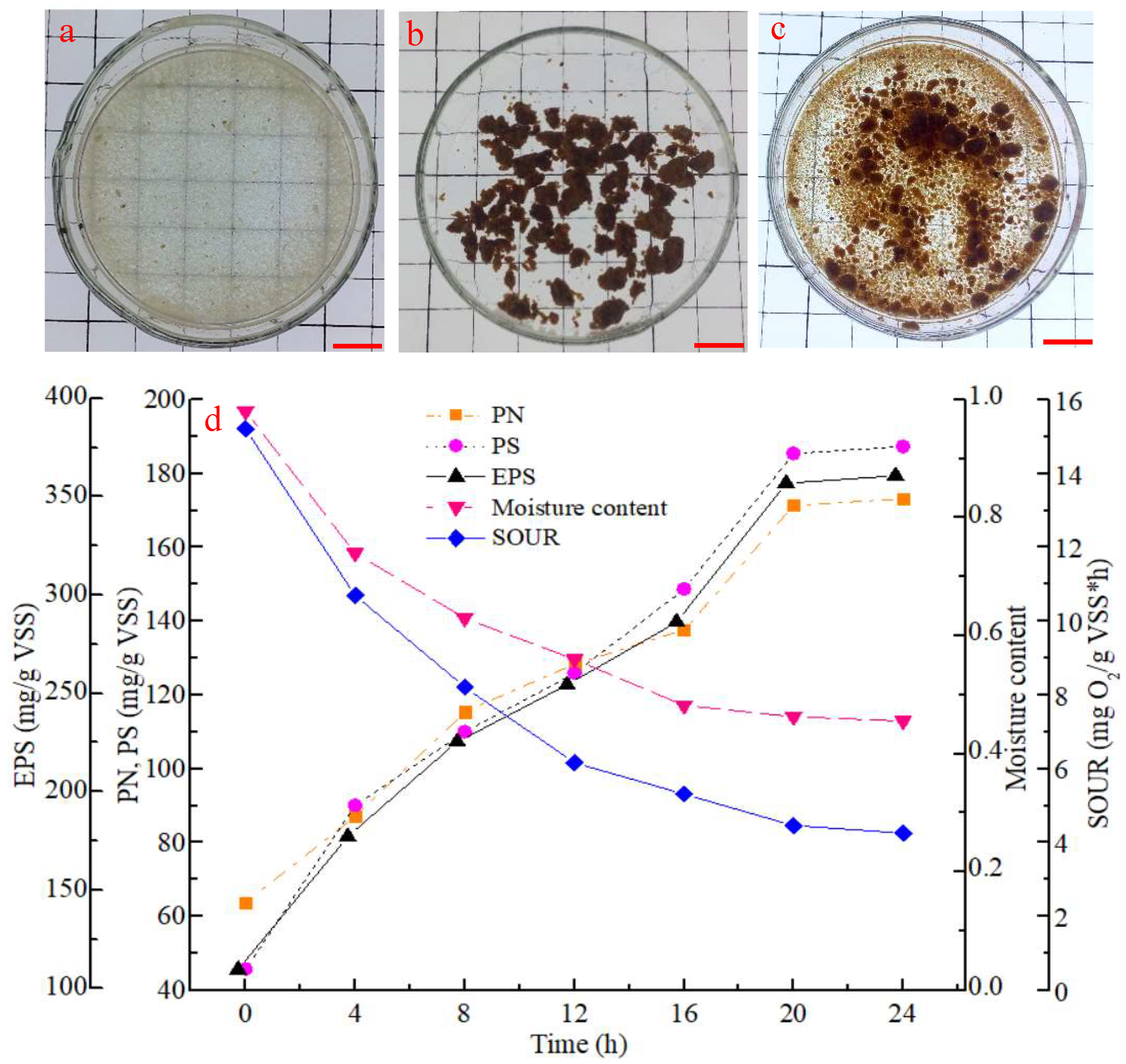
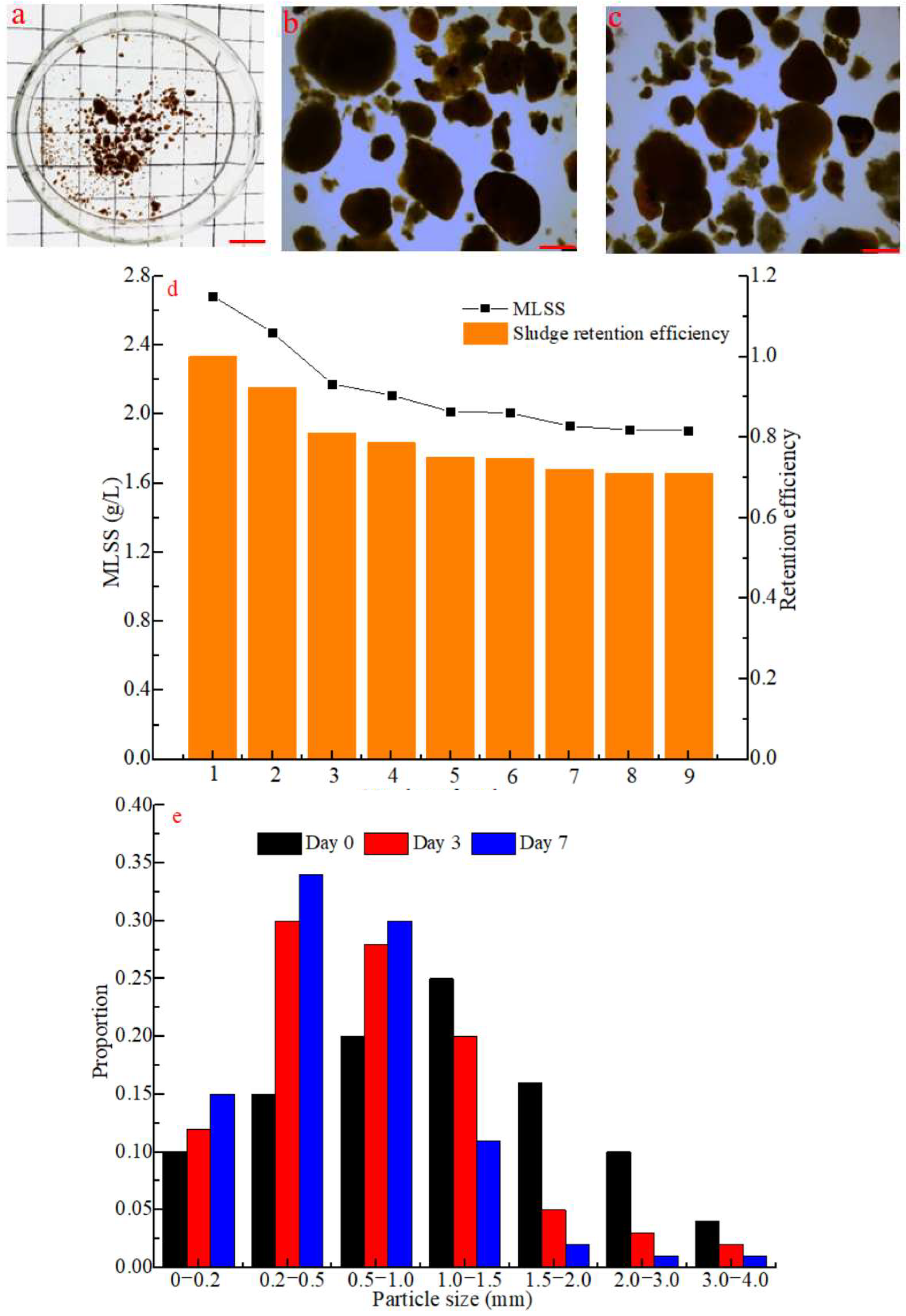
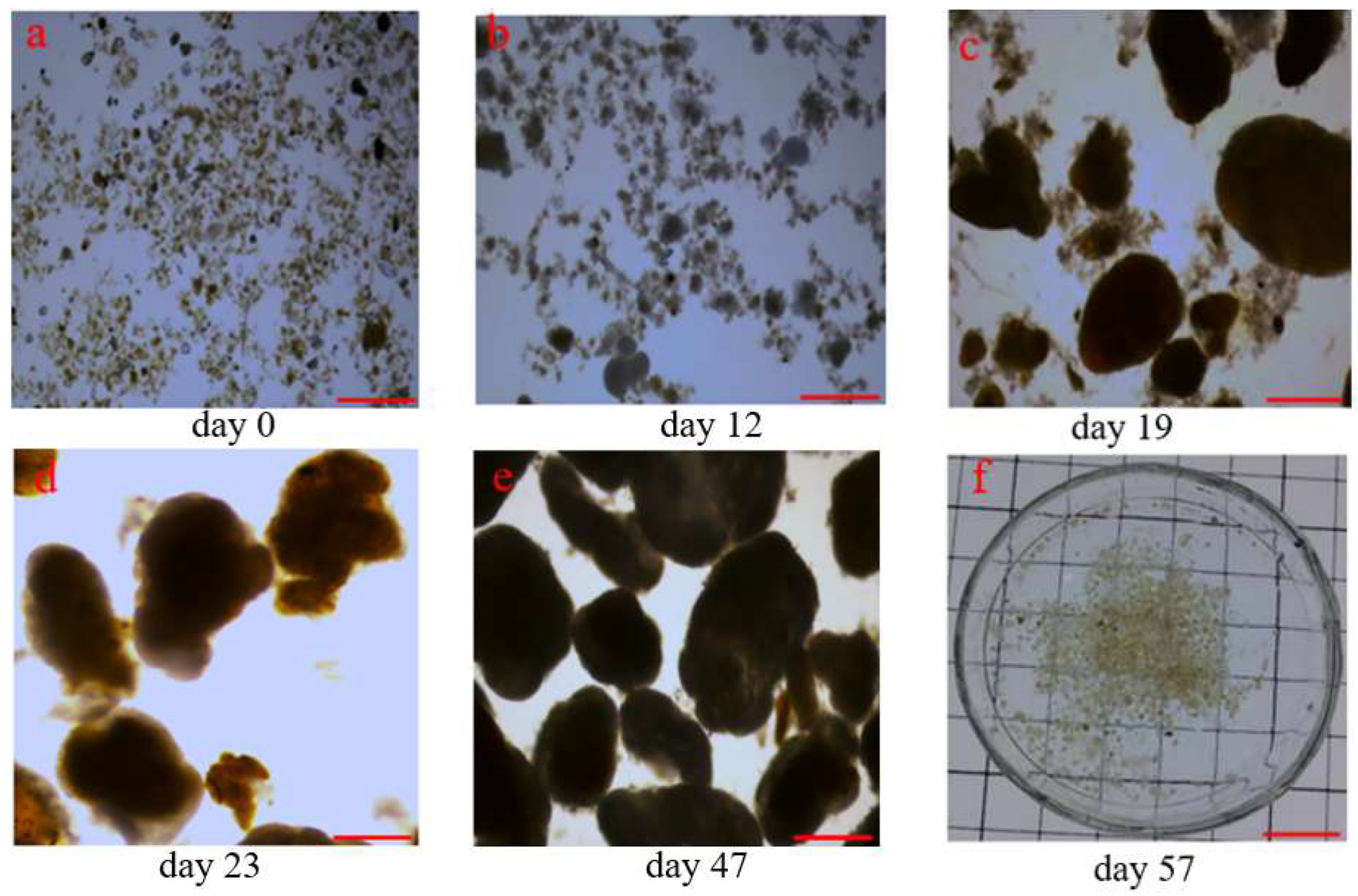

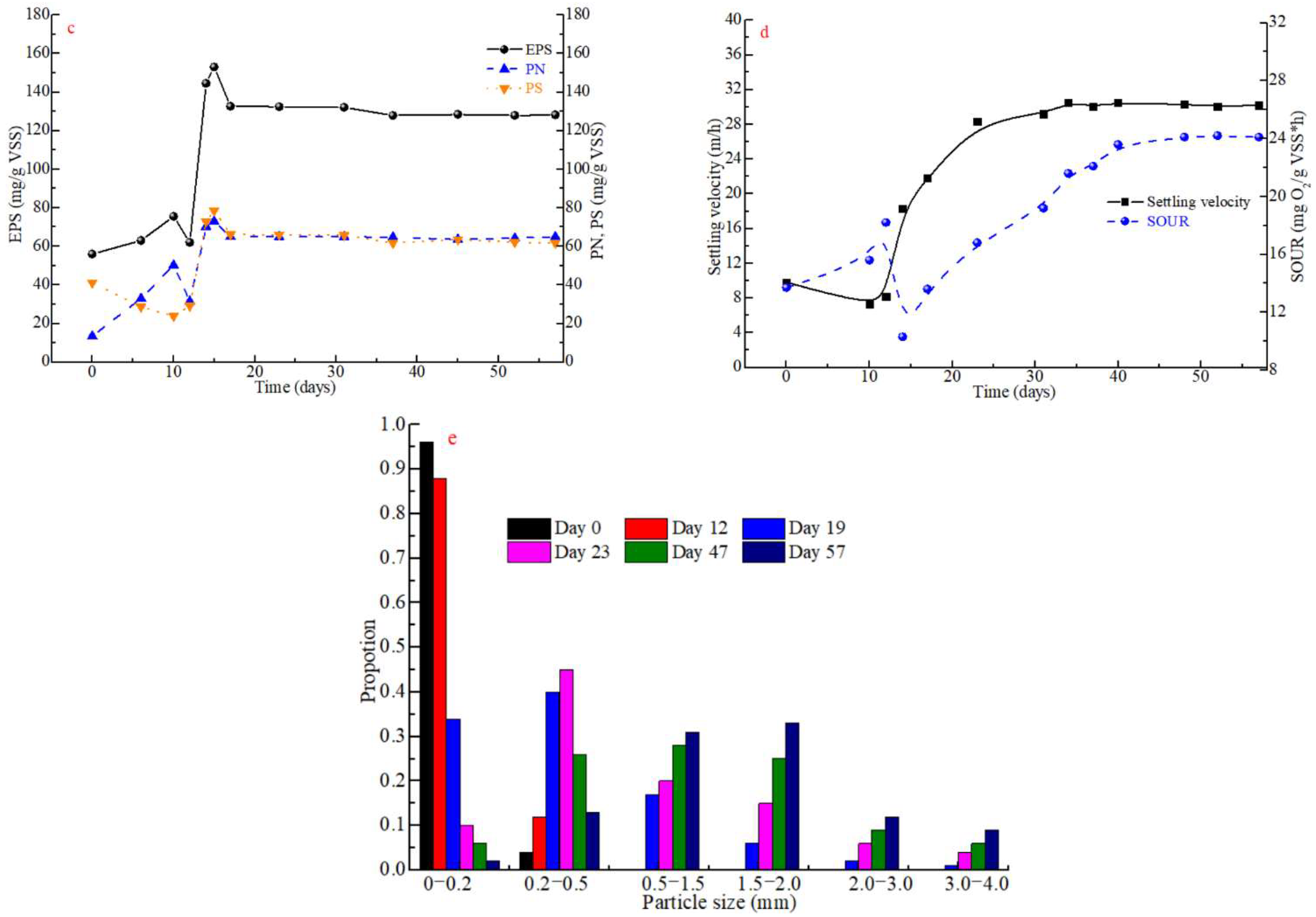
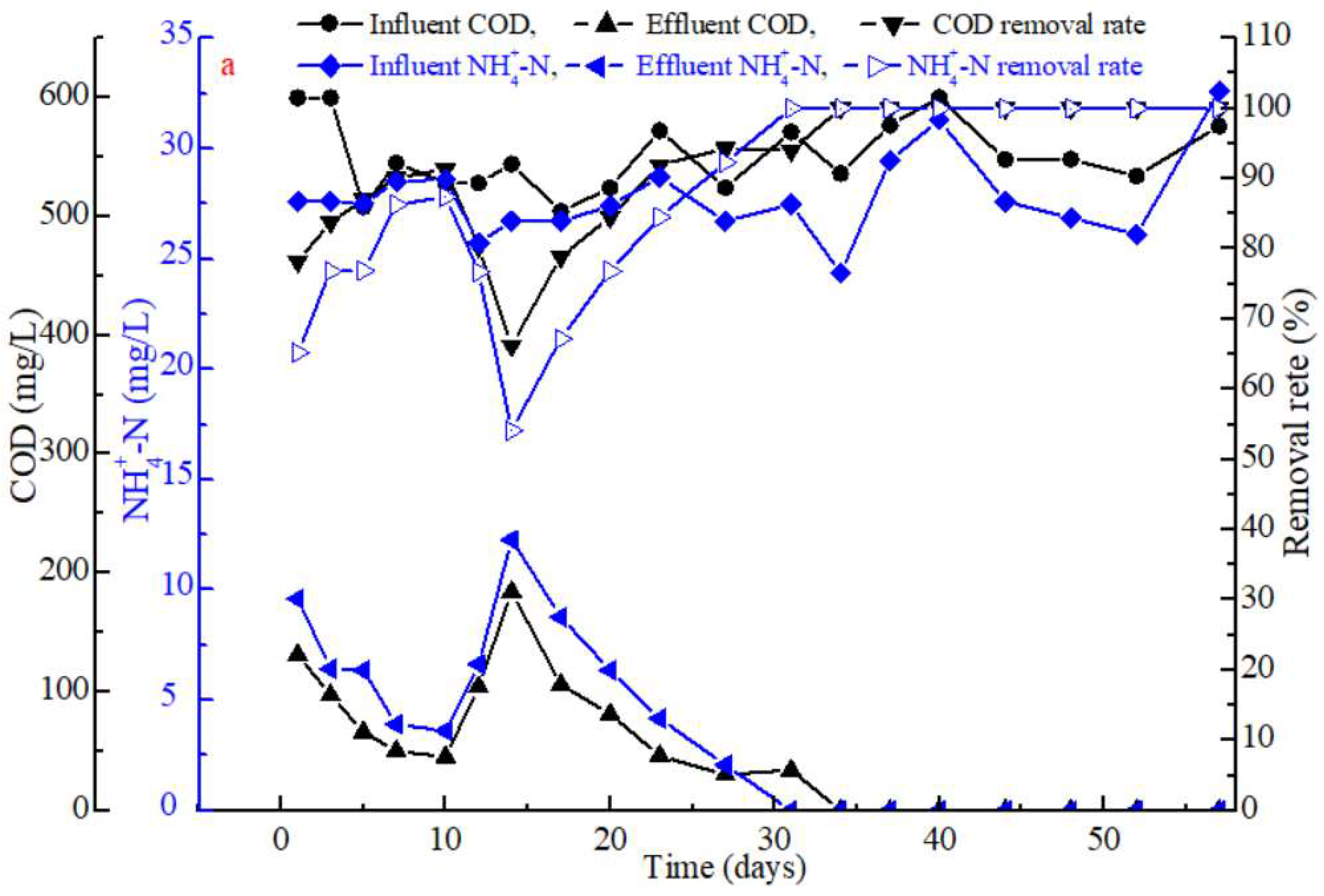
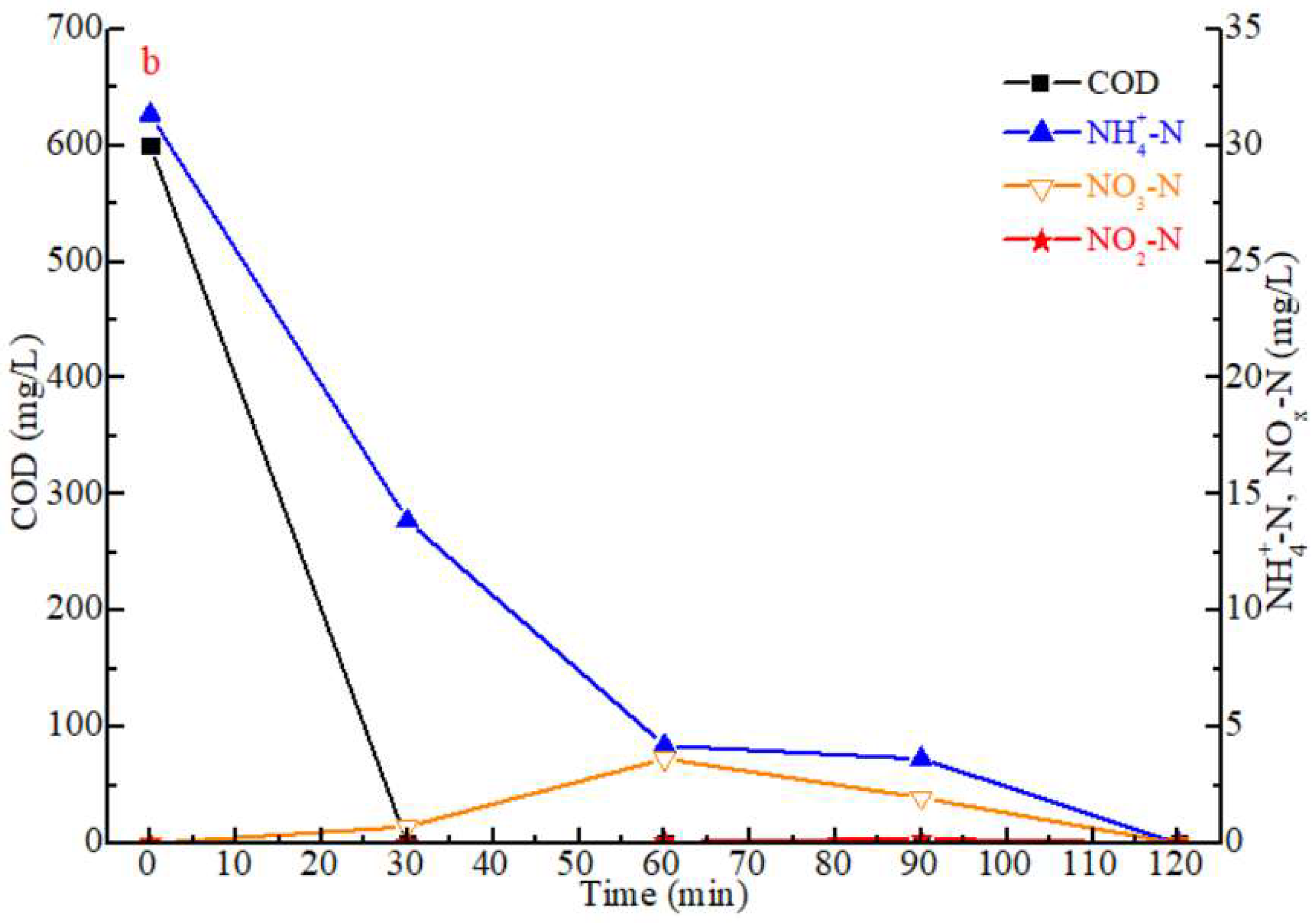
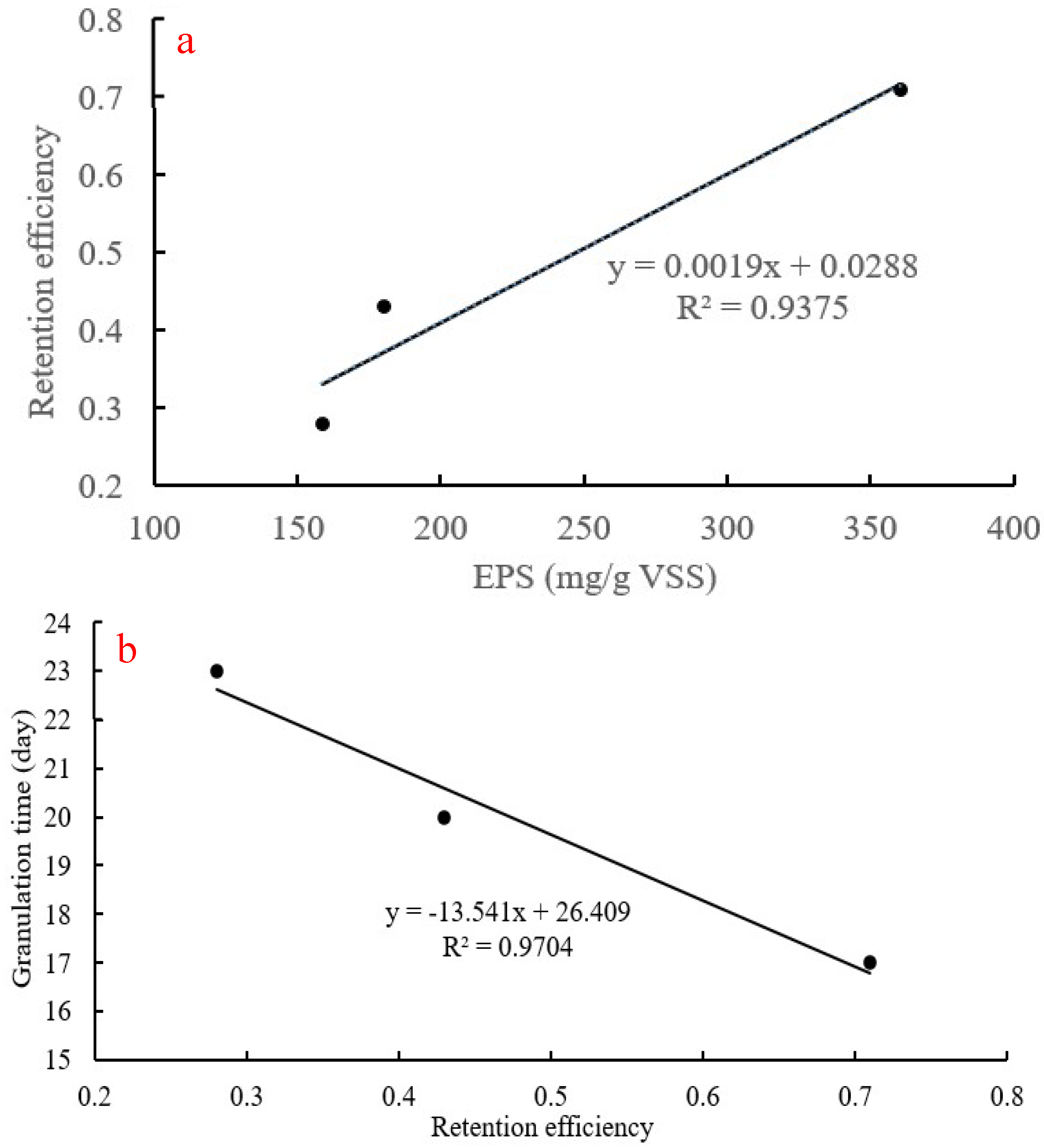
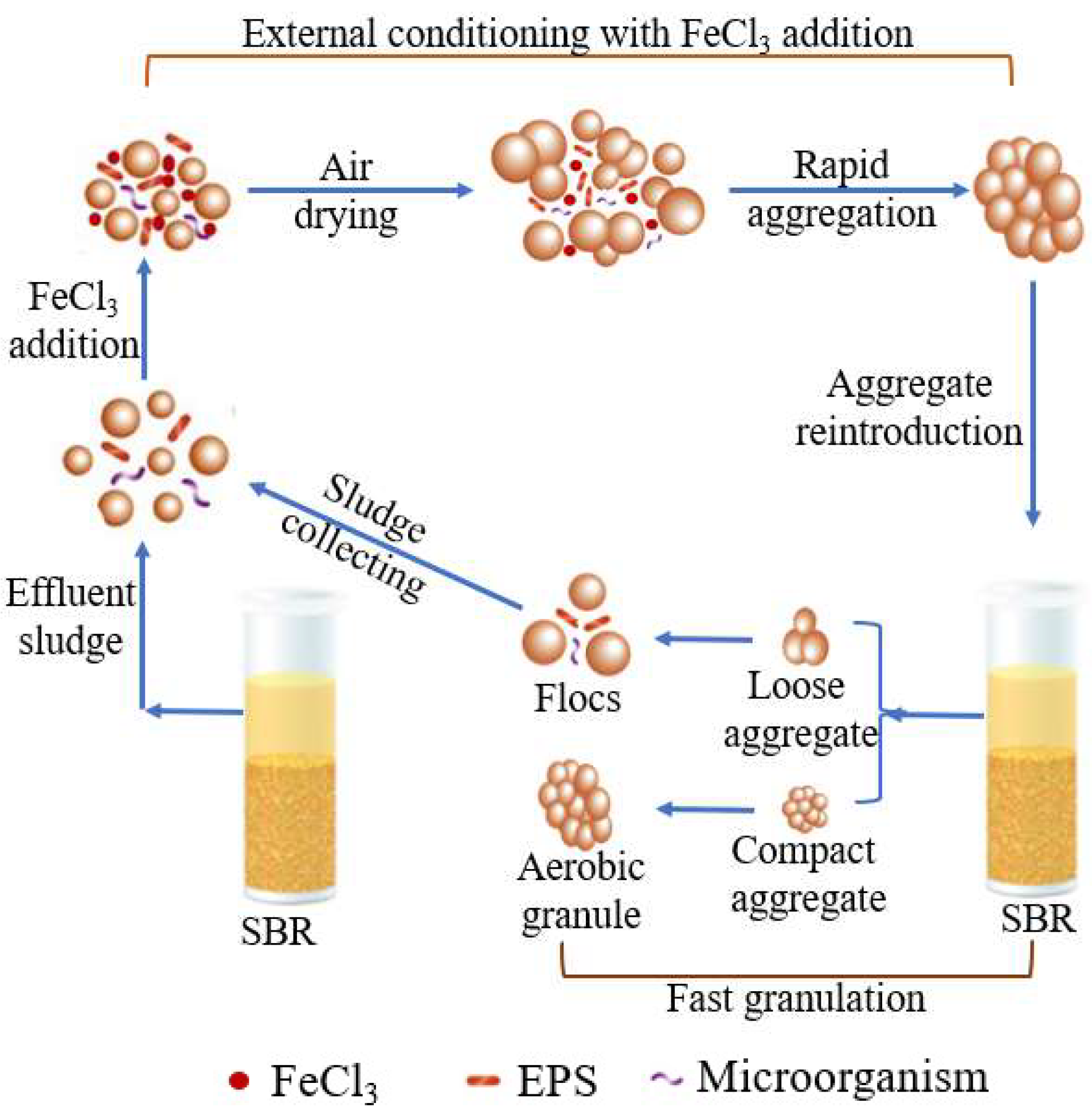
| Composition | Concentration (mg·L−1) | Composition | Concentration (mg·L−1) |
|---|---|---|---|
| NaAc | 1200 | CaCl2 | 21 |
| NH4Cl | 115 | MgSO4·7H2O | 102 |
| KH2PO4 | 63 | Trace element | 0.5 mL·L−1 |
| FeSO4·7H2O | 8 |
| Composition | Concentration (g·L−1) | Composition | Concentration (g·L−1) |
|---|---|---|---|
| H3BO3 | 0.2 | Na2Mo7O24·2H2O | 0.14 |
| CoCl2·6H2O | 0.2 | ZnSO4·7H2O | 0.2 |
| CuSO4·5H2O | 0.06 | KI | 0.06 |
| FeCl3·6H2O | 2 | NiCl2 | 0.12 |
| MnCl2·2H2O | 0.22 |
| External Conditioning Method | Sludge Properties during External Conditioning Process | Rapid Granulation | Study | |||||
|---|---|---|---|---|---|---|---|---|
| Time (h) | SOUR (mg O2 ·(VSS·h)−1) | MC | EPS (mg·(g·VSS)−1) | Retention Efficiency | Reintroduction Frequency | Time (d) | ||
| Natural drying | 72 | 5.26 | 0.52 | 158.6 | 0.28 | 7 | 23 | [23] |
| Ca2+ addition | 24 | 4.3 | 0.55 | 180.3 | 0.43 | 5 | 20 | [24] |
| Fe3+ addition | 24 | 4.25 | 0.45 | 360.5 | 0.71 | 3 | 17 | This study |
Publisher’s Note: MDPI stays neutral with regard to jurisdictional claims in published maps and institutional affiliations. |
© 2022 by the authors. Licensee MDPI, Basel, Switzerland. This article is an open access article distributed under the terms and conditions of the Creative Commons Attribution (CC BY) license (https://creativecommons.org/licenses/by/4.0/).
Share and Cite
Liu, J.; Yin, S.; Xu, D.; Piché-Choquette, S.; Ji, B.; Zhou, X.; Li, J. Fast Granulation by Combining External Sludge Conditioning with FeCl3 Addition and Reintroducing into an SBR. Polymers 2022, 14, 3688. https://doi.org/10.3390/polym14173688
Liu J, Yin S, Xu D, Piché-Choquette S, Ji B, Zhou X, Li J. Fast Granulation by Combining External Sludge Conditioning with FeCl3 Addition and Reintroducing into an SBR. Polymers. 2022; 14(17):3688. https://doi.org/10.3390/polym14173688
Chicago/Turabian StyleLiu, Jun, Shunchang Yin, Dong Xu, Sarah Piché-Choquette, Bin Ji, Xin Zhou, and Jun Li. 2022. "Fast Granulation by Combining External Sludge Conditioning with FeCl3 Addition and Reintroducing into an SBR" Polymers 14, no. 17: 3688. https://doi.org/10.3390/polym14173688
APA StyleLiu, J., Yin, S., Xu, D., Piché-Choquette, S., Ji, B., Zhou, X., & Li, J. (2022). Fast Granulation by Combining External Sludge Conditioning with FeCl3 Addition and Reintroducing into an SBR. Polymers, 14(17), 3688. https://doi.org/10.3390/polym14173688








